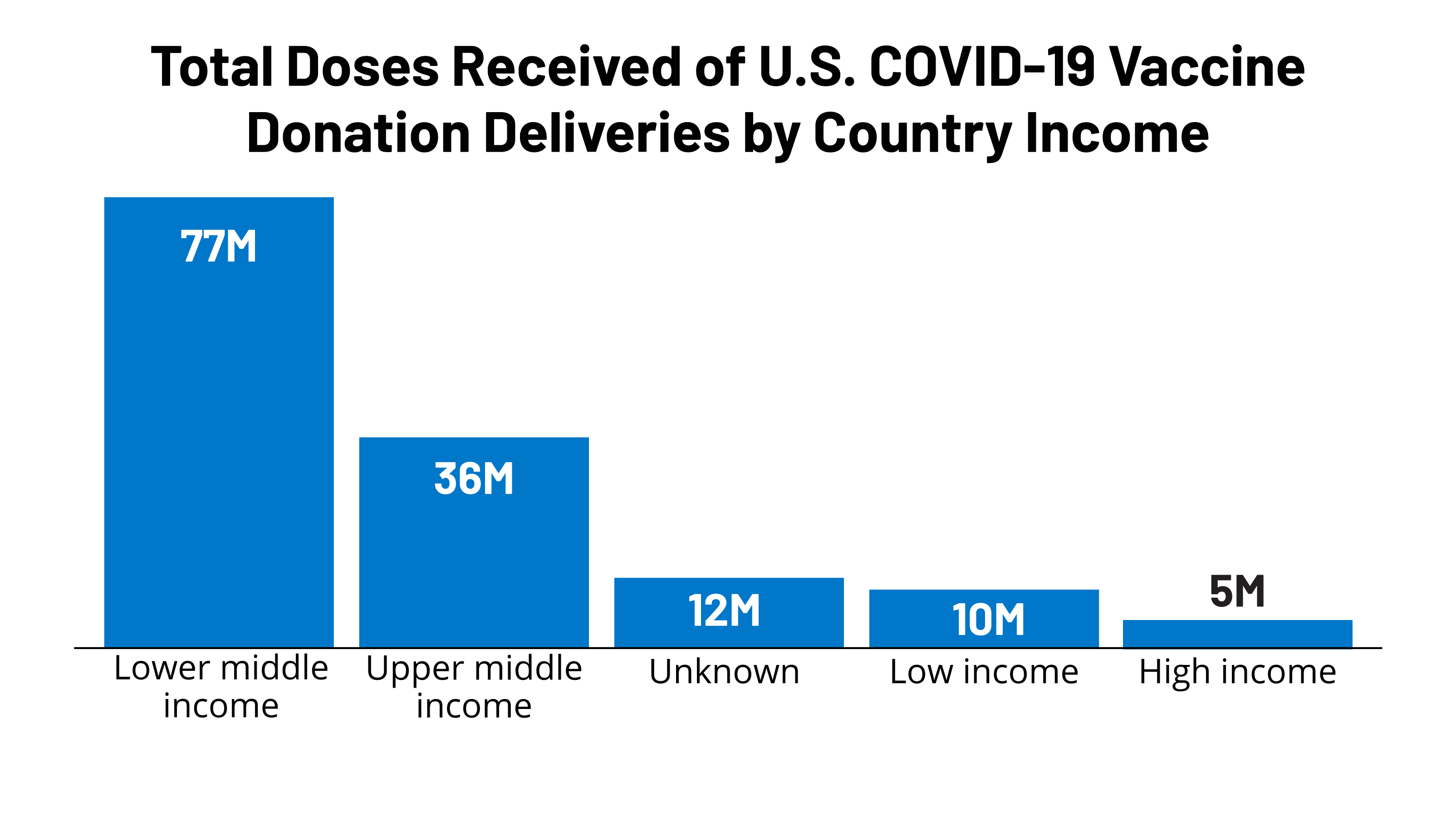There remains a significant gap in vaccine access across the world, with only 2% of the population in low-income countries (LICs) receiving at least one vaccine dose, compared to 30% in lower-middle-income countries (LMICs), 54% in upper-middle-income countries (UMICs), and nearly two-thirds in high-income countries (HICs). One way to address this gap is for countries that have vaccines to donate them to countries in need, either via the multilateral COVAX mechanism or directly to countries and/or regions via bilateral donations. For its part, the U.S. government has pledged to donate 580 million doses of COVID-19 vaccine for global use by 2022 and has been delivering doses to countries around the world since June. To understand more about these donated doses and where they have been directed, we analyzed data from the U.S. State Department, COVAX, and other sources. We find that, as of September 20, 2021:
- The U.S. has donated approximately 140 million doses to at least 93 countries (see Table 1 and Figure 1). The ten countries receiving the most doses include: Pakistan (15.8 million), Bangladesh (6.5 million), Philippines (6.4 million), Colombia (6.0 million), South Africa (5.7 million), Vietnam (5.0 million), Indonesia (4.5 million), Guatemala (4.5 million), Uzbekistan (4.2 million), and Nigeria (4.0 million).
- Looking by country income, more than half of U.S. doses have been donated to LMICs (see Figure 2). Of the 140 million doses delivered to date, approximately 77 million (55%) have been provided to LMICs, followed by UMICs (36 million, 26%), LICs (10 million, 7%), and HICs (5 million, 4%). When standardized by population, LMICs still account for the largest amount received (24.9 thousand doses per million population), while UMICs and LICs have received smaller amounts (13.5 thousand and 13.3 thousand doses per million population), and HICs receiving the smallest amount with 4.4 thousand doses per million population.
- Countries in the Western Hemisphere have received the most U.S. doses (both in total and when standardized by population size; see Figure 3). Forty million doses (28%) have been provided to countries in the Western Hemisphere, followed by South and Central Asia (35 million, 25%), Sub-Saharan Africa (29 million, 21%), East Asia and the Pacific (29 million, 20%), Middle East and North Africa (4 million, 3%), and Europe and Eurasia (4 million, 3%). When standardized based on population size, the number of doses received by countries in the Western Hemisphere (50.1 thousand per million) is more than double the next largest region (Sub-Saharan Africa; 22.7 thousand doses per million population).
- The Moderna vaccine accounts for the largest share of U.S. donated doses (see Figure 4). Of the 140 million doses provided to date, 42% are Moderna, followed by Pfizer (25%), and Johnson & Johnson (19%).
- The majority of U.S. donated doses have been provided through COVAX (see Figure 5). Approximately 53% of doses (74.7 million) have been provided through COVAX with 38% (54.0 million doses) provided directly to the recipient country.
- The bulk of U.S. COVID-19 vaccine donations occurred in July 2021. By number of deliveries, most occurred in July (64 deliveries or 50%), followed by August (36 deliveries, 28%), June (7 deliveries, 6%), and through September 20 (17 deliveries, 13%). By number of doses delivered, most doses were still delivered in July (82.4 million doses, or 59%), followed by August (17.6 million doses, 13%), through September 20 (14.4 million doses, 10%), and June (12.3 million doses, 9%).
President Biden has said the U.S. will be the “arsenal of vaccines” for the globe, and the 140 million doses donated by the U.S. to date represent one component of the U.S. effort to expand access to Covid-19 vaccines. While the doses provided so far make the U.S. the single largest donor of vaccines worldwide, these donations remain a fraction of what the U.S. has promised to provide by the end of this year and into next and are far from sufficient to meet global needs. Continued monitoring of U.S. donations will help gauge progress toward meeting its global vaccination goals.

